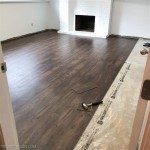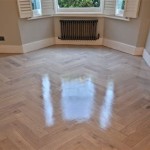Laying Wood Plank Flooring: A Comprehensive Guide
Installing wood plank flooring can significantly enhance the beauty and value of your home. Whether you're a seasoned DIY enthusiast or tackling your first flooring project, this guide will provide you with step-by-step instructions and essential tips to ensure a successful installation.
1. Planning and Preparation
Before embarking on the installation, it's crucial to meticulously plan your project. Measure the area where the flooring will be laid, and calculate the quantity of materials you'll need. Additionally, ensure the subfloor is level, dry, and free of debris or imperfections. If necessary, install an underlayment to provide a smooth and stable base for the planks.
2. Acclimating the Planks
Prior to installation, allow the wood planks to acclimate to your home's temperature and humidity for at least 72 hours. This ensures the planks don't buckle or shrink once they're laid. Stack the planks in a well-ventilated area with consistent conditions.
3. Starting Row and Layout
Before laying the first row, decide which direction the planks will run. Begin by installing a spacer along the wall to maintain a consistent gap between the planks and the wall. Position the first plank snugly against the spacer, ensuring the tongue side faces out.
4. Joining the Planks
To connect the planks, angle the tongue of the next plank into the groove of the installed plank. Tap the plank gently into place using a tapping block and hammer. Continue this process until you reach the end of the row.
5. Cutting and Fitting Planks
For the last plank in each row, measure and cut it to fit the remaining space. Use a miter saw for precise cuts. When cutting around protruding objects, such as pipes, trace the obstacle onto the plank and cut carefully to fit.
6. Staggering Joints
As you progress through the installation, stagger the joints between the planks in subsequent rows. This reduces the likelihood of the joints aligning and creating weak spots in the flooring. Aim for a minimum offset of 6 inches between joints.
7. Installing the Remainder
Once you've completed most of the flooring, you may encounter areas where full-sized planks cannot be used. In these cases, cut smaller pieces to fit. Be sure to leave a small gap at the ends of the planks to allow for expansion.
8. Trim and Moldings
After the planks are installed, install baseboards, quarter round, or other moldings to conceal the gaps around the perimeter and create a finished look. Cut the moldings to length and nail or glue them in place.
Tips for a Successful Installation
- Use a high-quality underlayment to provide support and reduce noise.
- Tap the planks firmly but gently to avoid damaging the locking system.
- Leave a small gap between the planks and the wall to allow for expansion.
- Stagger the joints to create a more stable floor.
- Use a moisture barrier under the underlayment in areas prone to moisture.
- Allow the floor to cure for 24 hours before walking on it.
- Vacuum or sweep the floor regularly to maintain its appearance and longevity.

How To Install Hardwood Flooring For Beginners

Make Your Own Plank Flooring Using 1 X 12 Lumber Hallstrom Home

Determining The Direction To Lay Install Hardwood Laminate Or Luxury Vinyl Plank Flooring

Hardwood Flooring Installation Step By Forbes Home
:strip_icc()/101206837-1dd14e2eaebe404e9c0e3fd1494b7c77.jpg?strip=all)
How To Install Hardwood Floors

Guide How To Install A Solid Hardwood Floor

How To Install Laminate Flooring For Beginners
Diy Wide Plank Pine Floors Part 1 Installation The Roots Of Home

How To Install A Barn Board Floor Over Concrete Tutorial Diy Passion

Diy Wood Floors Flooring
See Also







